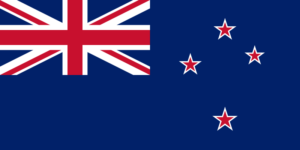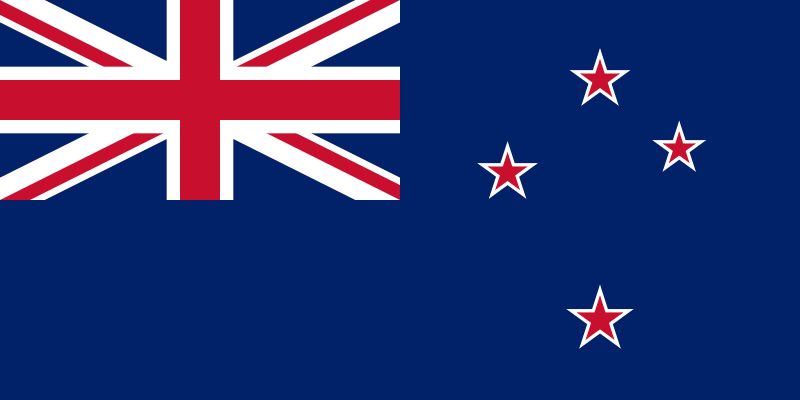Geography of New Zealand • Maps • Interesting Facts • Flag
Area: 267716 km ²
Population: 5.2 Million (2024)
Population Density: 18 / km ²
Dominant Language: English, Maori
Dominant Religion: Christianity
Political System: Parliamentary system and constitutional monarchy
Climate Type: Temperate
Currency: New Zealand Dollar (NZD)
Major Industries: Agriculture, Dairy and food processing, Forestry, Coal Mining
Flag of New Zealand:

The flag of New Zealand features a dark blue field with the Union Jack (the flag of the United Kingdom) in the upper hoist-side quadrant. The presence of the Union Jack symbolizes New Zealand’s historical ties to the United Kingdom.
On the fly side of the flag, there are four red, five-pointed stars, each with a white border. These stars are arranged to represent the Southern Cross constellation, which is a prominent constellation visible in the southern hemisphere. The stars reflect New Zealand’s location in the South Pacific.
The blue background represents the sky and the sea surrounding New Zealand, while the stars and their arrangement signify the country’s geographic positioning.
History of New Zealand
Around 1,000 A.D., the Maori people travelled from islands in Polynesia close to Tahiti. Abel Tasman, a Dutch adventurer, visited the islands in the 1600s, but he and his group departed after being attacked.
Captain James Cook visited the islands in 1769. In 1840, the Maori and the British signed a treaty and the British constructed settlements. After their lands were taken, the Maori objected to the treaty, and in the 1860s they launched a 12-year battle against the British to retake North Island. The 1870s saw the islands return to peace.
The first nation to grant women the right to vote was New Zealand in 1893. In 1907, the nation became a dominion of Britain, and in 1947, it achieved independence.
Geography of New Zealand
New Zealand’s two main islands, North and South Islands, are separated by the Cook Strait. Australia, its neighbour, is 1,000 miles (1,600 kilometres) away.
The islands were created just 23 million years ago when land was thrust out of the ocean by volcanic forces. New Zealand has more than 50 volcanoes, some of which are still active today.
The South Island is home to the highest mountain peak in New Zealand, Mount Cook, which rises to 12,316 feet (3,754 meters) and is called “Cloud Piercer” by the Maori people.
New Zealand Map

New Zealand Political Map

New Zealand is divided into 16 regions, each with its own Regional Council and mayor, and is further divided into districts and cities. These regions include Northland; Auckland; Waikato; Bay of Plenty; Gisborne; Hawke’s Bay; Taranaki; Manawatu-Wanganui; Wellington; Tasman; Nelson; Marlborough; West Coast; Canterbury; Otago; and Southland.
New Zealand Interesting Facts
- Rings of Fire: New Zealand lies along the Ring of Fire, a belt of active volcanoes and earthquake epicentres bordering the Pacific Ocean; up to 90% of the world’s earthquakes and some 75% of the world’s volcanoes occur within the Ring of Fire
- First to See the Sunrise: The East Cape of New Zealand is among the first places in the world to see the sunrise each day due to its unique geographic location.
- No Snakes: Just like Ireland, there are no native snakes in New Zealand. The country even has strict biosecurity laws to keep it that way!
- Hobbiton: Fan of Lord of the Rings? New Zealand is home to the Shire!! The famous movie set from The Lord of the Rings and The Hobbit trilogies, Hobbiton, is located in Matamata, New Zealand, and is a popular tourist destination.
- Land of Kiwis: Did you know that the New Zealanders are often called “Kiwis,” because the tiny, cute, flightless birds are native to the country and not found anywhere else? They are so unique that the bird is a national symbol.
- Home of Extreme Sports: New Zealanders love adventure sports. They are known for adventure sports like bungee jumping, skydiving, and zorbing. It is home to the world’s first commercial bungee jumping site in Queenstown.
- Diverse Ecosystems: New Zealand is a small country yet it has stunningly diverse landscapes from beaches and rainforests to glaciers, mountains, and volcanoes
- More Sheep than People: New Zealand is a sheep-farming powerhouse. It is so huge that there are 5 times more sheep than people. In simple words, there are about five sheep for every person.
- Nuclear-Free Zone: New Zealand is one of the world’s nuclear-free zones. In 1987 it passed legislation, banning nuclear-powered or armed vessels from entering its waters
- Māori Culture: Ever seen the powerful war dance, the haka on a rugby field or by a parliamentarian girl from New Zealand? The indigenous Māori culture is an important part of New Zealand’s identity. The Māori language is one of the country’s official languages.
- No Land Predators: New Zealand has no native land mammals except for bats, and it has no land predators like a Lion, a Tiger, a Wolf or a Bear.
Geography of Bazil: Watch now
A hidden gem nestled in the mountains of Europe Watch now
Read about Argentina here: Argentina
